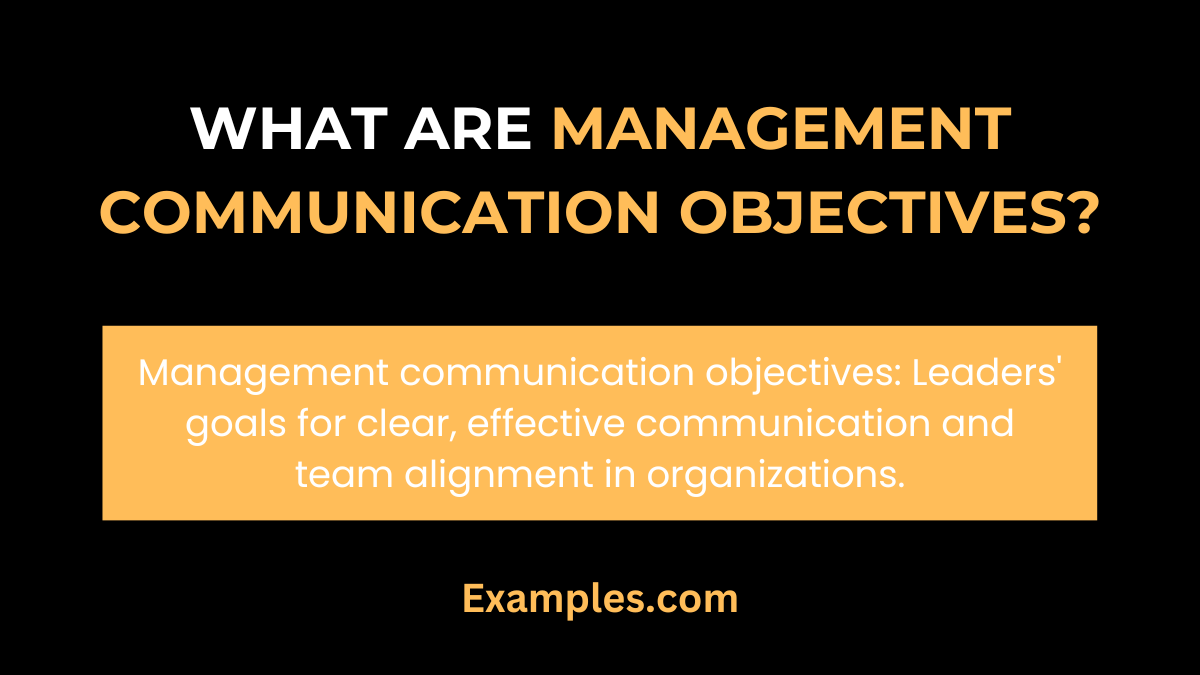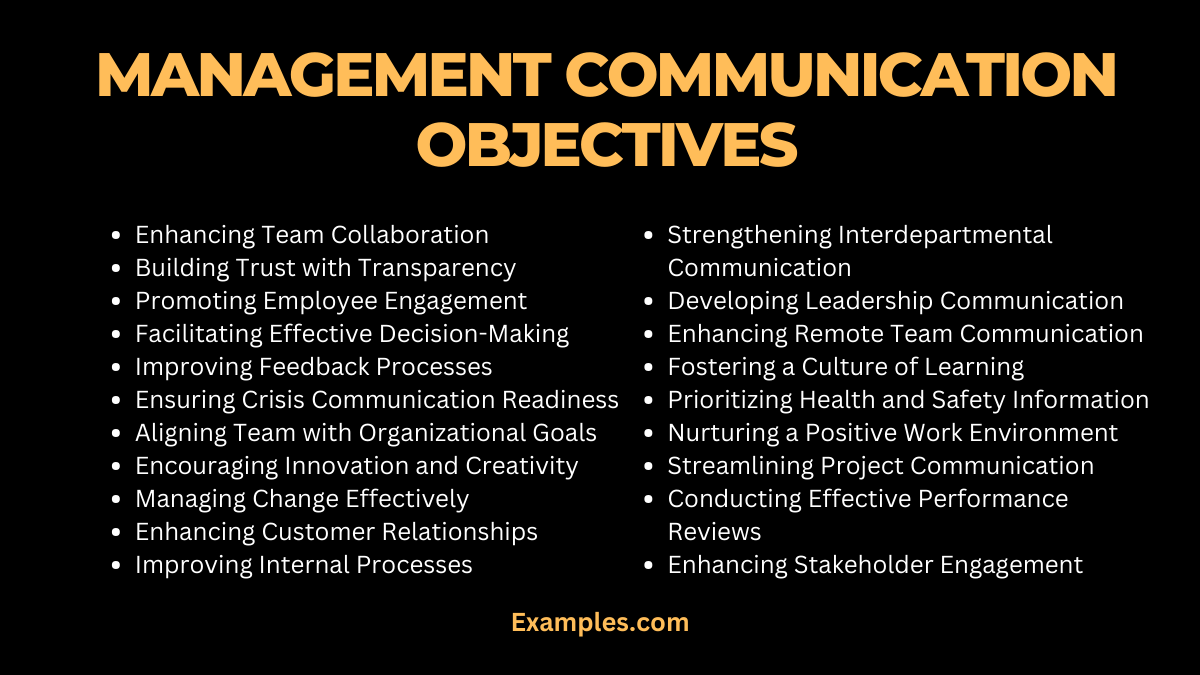Management Communication Objectives
In the realm of management, clear and effective communication is pivotal. Understanding and implementing robust management communication objectives can profoundly influence team dynamics, decision-making, and overall organizational success. This guide delves into practical of communication objectives example, offering insights into how managers can convey their messages more effectively. Whether it’s to inspire, inform, or engage, these objectives serve as a roadmap for impactful communication, tailored to diverse managerial contexts. Including real-world scenarios, this guide offers a comprehensive look at how to achieve your communication goals effectively, enhancing both leadership presence and team collaboration.
What are Management Communication Objectives?

Management communication objectives are specific goals set by leaders to guide their interactions with team members and stakeholders. These objectives focus on ensuring clarity, consistency, and effectiveness in conveying messages, facilitating decision-making, and fostering a positive work environment. They are crucial in aligning team efforts, building trust, and promoting open dialogue within an organization, ultimately contributing to its success and growth.
25 Examples of Management Communication Objectives

- Objective: Enhancing Team Collaboration: Foster a cohesive team environment through clear and frequent communication.
Example: Conduct weekly team meetings to discuss project progress and encourage open dialogue about challenges. - Objective: Building Trust with Transparency: Communicate openly about company changes and decisions to build trust among employees.
Example: Share monthly updates on company performance and future plans in town hall meetings. - Objective: Promoting Employee Engagement: Use communication to engage and motivate employees, enhancing their commitment to the organization.
Example: Organize regular one-on-one check-ins to discuss employee goals and offer support. - Objective: Facilitating Effective Decision-Making: Provide clear and concise information to help team members make informed decisions.
Example: Share detailed briefs before decision-making meetings to ensure everyone is well-informed. - Objective: Improving Feedback Processes: Establish a two-way communication channel for feedback to enhance performance and development.
Example: Implement a 360-degree feedback system where employees can receive and give feedback. - Objective: Ensuring Crisis Communication Readiness: Prepare and communicate effectively during crises to maintain stability and confidence.
Example: Develop a crisis communication plan and train team leaders on how to convey critical information during emergencies. - Objective: Aligning Team with Organizational Goals: Regularly communicate the company’s vision and goals to ensure team alignment.
Example: Use quarterly meetings to revisit and discuss how team efforts align with the company’s strategic objectives. - Objective: Encouraging Innovation and Creativity: Create an open environment where employees feel comfortable sharing innovative ideas.
Example: Host monthly brainstorming sessions and encourage team members to propose new ideas. - Objective: Managing Change Effectively: Communicate clearly about organizational changes to facilitate smooth transitions.
Example: Send detailed emails explaining the reasons and impacts of upcoming changes. - Objective: Enhancing Customer Relationships: Use effective communication to build and maintain strong relationships with clients.
Example: Regular client check-ins and updates to ensure their needs are being met and to gather feedback. - Objective: Improving Internal Processes: Clearly communicate about new processes or changes to existing ones for efficiency.
Example: Introduce new software or processes in training sessions, providing clear instructions and support. - Objective: Strengthening Interdepartmental Communication: Encourage communication between different departments to improve coordination and understanding.
Example: Organize cross-departmental meetings to discuss collaborative projects and share insights. - Objective: Developing Leadership Communication: Tailor communication styles to effectively lead and inspire team members.
Example: Attend leadership communication workshops to learn different communication strategies for various situations. - Objective: Enhancing Remote Team Communication: Adapt communication methods to effectively manage and engage remote teams.
Example: Utilize video conferencing tools for regular check-ins and team building activities. - Objective: Fostering a Culture of Learning: Communicate about educational opportunities and encourage continuous learning within the team.
Example: Share information about relevant online courses and workshops for professional development. - Objective: Prioritizing Health and Safety Information: Communicate health and safety protocols clearly to ensure employee wellbeing.
Example: Send regular updates on safety guidelines and conduct safety training sessions. - Objective: Nurturing a Positive Work Environment: Use communication to create a supportive and inclusive workplace culture.
Example: Celebrate team achievements and milestones through internal newsletters or meetings. - Objective: Streamlining Project Communication: Establish clear channels for project-related communication to ensure efficiency and clarity.
Example: Set up a project management tool for team members to update their progress and share information. - Objective: Conducting Effective Performance Reviews: Communicate performance expectations and feedback clearly during reviews.
Example: Use structured templates for performance reviews, providing clear and constructive feedback. - Objective: Enhancing Stakeholder Engagement: Maintain regular communication with stakeholders to keep them informed and involved.
Example: Send quarterly newsletters to stakeholders, outlining company progress and future plans.
Each of these objectives, with their respective examples, emphasizes the importance of strategic communication in management, highlighting how effective communication can lead to improved team dynamics, decision-making, and overall organizational success.
Management Communication Objectives for Business
- Enhancing Decision-Making: Effective communication aids in providing clear, accurate information, crucial for sound decision-making.
Example:For instance, detailed reports and briefings can lead to more informed business decisions. - Improving Efficiency: Streamlined communication minimizes misunderstandings, leading to more efficient business operations.
Example:Regular team briefings ensure everyone is on the same page, reducing errors and delays. - Facilitating Change Management: Clear communication is essential for successfully implementing changes within a business.
Example: transparently discussing organizational changes helps in smoother transitions. - Building Brand Reputation: Consistent and honest communication helps in establishing a positive brand image.
Example:Public statements and press releases should reflect the company’s values and integrity. - Strengthening Stakeholder Relations: Maintaining open lines of communication with stakeholders builds trust and loyalty.
Example:Regular updates to investors and stakeholders about company progress are vital. - Supporting Crisis Management: Effective communication is key in managing business crises effectively.
Example: clear internal and external communication strategies during a crisis can mitigate negative impacts. - Enhancing Market Presence: Strategic communication can increase a business’s visibility and influence in the market.
Example:Utilizing various communication channels to announce new products or services effectively widens market reach.
Management Communication Objectives at Workplace
- Promoting Team Collaboration: Clear communication fosters teamwork and collaboration among employees.
Example: Encouraging open discussions in team meetings enhances collaboration. - Building a Positive Work Culture: Transparent and respectful communication contributes to a healthy and positive work environment.
Example: Regular feedback sessions can help in maintaining a positive atmosphere. - Conflict Resolution: Effective communication skills are crucial for resolving workplace conflicts constructively.
Example: Mediation meetings with clear communication guidelines can resolve conflicts effectively. - Employee Development: Providing constructive feedback and career advice aids in employee growth and development.
Example: Periodic performance reviews with clear communication help in guiding employee development. - Enhancing Employee Engagement: Keeping employees informed and involved through communication increases their engagement and satisfaction. Internal newsletters highlighting company news and achievements can boost engagement.
- Managing Workforce Diversity: Effective communication is essential in managing and embracing workforce diversity.
Example: Cultural sensitivity training and inclusive communication policies are key. - Facilitating Remote and Hybrid Work: Clear communication protocols are crucial for managing remote or hybrid work environments.
Example: Regular virtual check-ins ensure remote teams remain connected and informed.
Management Communication Objectives for Employees
- Clarifying Roles and Responsibilities: Clear communication helps employees understand their roles and expectations.
Example: Job descriptions and regular briefings can ensure clarity in roles. - Improving Skills and Competencies: Communicating about training and development opportunities enhances employee skills.
Example: Announcing available training programs and encouraging participation is essential. - Boosting Morale and Motivation: Positive communication can greatly impact employee morale and motivation.
Example: Acknowledging achievements and providing constructive feedback are key practices. - Ensuring Safety and Compliance: Communicating safety protocols and compliance guidelines is crucial for a safe workplace.
Example: Regular safety briefings and updates are necessary for compliance. - Facilitating Employee Feedback: Encouraging and acting on employee feedback improves communication and operations.
Example: Surveys and suggestion boxes are effective tools for gathering feedback. - Supporting Work-Life Balance: Communicating about flexible work options supports employees’ work-life balance.
Example: Emails detailing flexible working policies can help employees manage their work and personal life better. - Promoting Health and Well-being: Communication about wellness programs and health benefits supports employee well-being.
Example: Health and wellness newsletters and seminars can promote a healthy lifestyle among employees.
Management communication objectives play a crucial role in the smooth operation and success of any business. They encompass a range of goals from enhancing decision-making and efficiency to improving employee engagement and workplace culture. Effectively setting and achieving these objectives requires clear, consistent, and strategic communication, ensuring that everyone from stakeholders to employees is informed, involved, and aligned with the company’s vision and goals.



